Constantine VII › Empress Zoe » Ancient origins
Articles and Definitions › Contents
- Constantine VII › Who Was
- Empress Zoe › Who Was
Ancient civilizations › Historical and archaeological sites
Constantine VII › Who Was
Definition and Origins
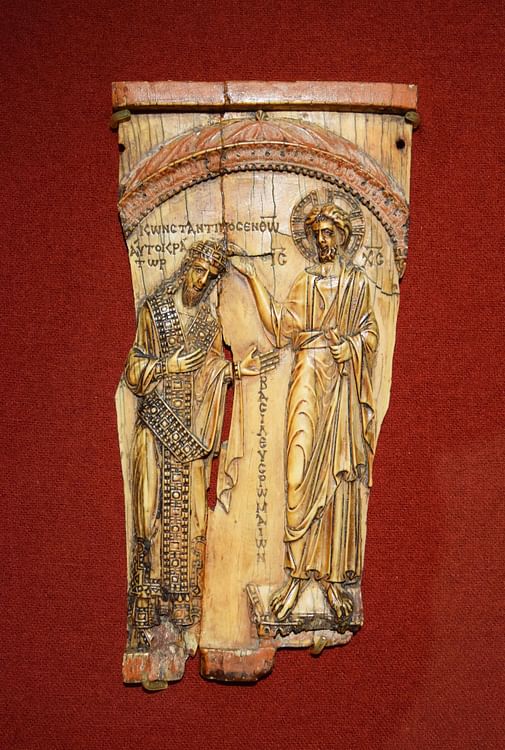
SUCCESSION & REGENTS
Constantine was born in 906 CE; his mother was Zoe Karvounopsina, fourth wife of emperor Leo VI (886-912 CE). As such, the emperor was a member and fourth ruler of the Macedonian dynasty founded by Basil I (r. 867-886 CE). Constantine, as was the tradition, had already been crowned co-emperor by his father in 908 CE, and when Leo died on 11 May 912 CE, his only male heir, Constantine VII, took the throne just a few days shy of his eighth birthday.
Constantine VII, like his father Leo VI, was “born in the purple” or porphyrogennetos. The phrase derived from the porphyry, a rare purple-laced marble, that was used in the chamber of the palace at Constantinople where Leo's birth, and many subsequent ones, took place. The restriction that only royalty wore robes made with Tyrian purple dated back to Romantimes, and this new tradition was one more attempt to further reinforce the legitimacy of dynastic succession and deter would-be usurpers. With many regents and pretenders to his throne, Constantine's claim to legitimacy would prove a very valuable one indeed.
THE BYZANTINE EMPIRE WAS REGAINING SOME OF ITS LOST LUSTRE & CONSTANTINE'S COURT BEGAN TO ATTRACT DIGNITARIES EAGER TO SEE FOR THEMSELVES THIS LEARNED YOUNG EMPEROR.
Because of his young age, Constantine's uncle Alexander acted as his regent. Alexander, a drunken roisterer infamous for his cruelty and debauched lifestyle, died in 913 CE while performing pagan sacrifices in the Hippodrome of Constantinople. It was just as well for the young Constantine as Alexander had boasted he would have the boy castrated. Constantine's next regent was Nicholas I Mystikos, the Patriarch (bishop) of Constantinople, with one of Nicholas' first acts being to dismiss his rival the emperor's mother to a convent. Zoe was shorn of her hair and henceforth would only be known as Sister Anna. Although a revolt led by the usurper Constantine Doukas was quashed, the bishop proved inadequate in responding to the threat of Symeon, Tsar of the Bulgars, who was as troublesome now as he had been during Leo VI's reign. Symeon's armies were almost at the gates of Constantinople, and the reeling empire was obliged to meet his peace terms which included marrying his daughter to Constantine VII.
A faction of the Byzantine court baulked at the idea of merely handing over power to the Bulgar emperor and staged a coup d'etat. Consequently, in February 914 CE, Constantine's mother returned from the political wilderness, called off the proposed marriage alliance and acted as her son's third regent. Zoe, although enjoying some military success against the Arabs, turned out to be just as ineffectual in staving of the Bulgars' renewed attacks in the Balkans and Greece, and she was forced to step down in 919 CE, undergo another haircut and retreat back to her nunnery. Romanos I Lekapenos, commander of the Byzantine navy, took his chance and became regent number four in 920 CE. He enjoyed certain successes against the Arabs in Mesopotamia, capturing Melitene, Nisibis, Dara, Amida, Martyropolis, and Edessa. To cement his position, Romanos had his daughter Helena marry Constantine, had himself crowned co-emperor and declared senior to Constantine, and then even had his three sons crowned as co-emperors.
Romanos may have initially been planning to found a new dynasty of his own, but the project was practically sunk when his eldest and most capable son, Christopher, died in 944 CE. The co-emperor's other sons were too young and useless, and it seems likely their father planned to at last release the throne to its rightful occupant, Constantine VII. Romanos had, after all, a stake already in the Macedonian dynasty now that his daughter was empress. However, Romanos' two remaining sons had other plans and themselves staged a coup in 944 CE in which they exiled their father to a monastery. Fortunately for Constantine, there was significant support at court to return the throne to the legitimate line of descent, and the Romanos boys were kicked out of Constantinople on 27 January 945 CE. Constantine could finally take the throne in his own right, aged 39: it was better late than never.
LAND REFORMS
Constantine continued the agrarian reforms of Romanos I and sought to rebalance wealth and tax responsibilities, thus, the larger estate owners ( dynatoi ) had to return lands they had acquired from the peasantry since 945 CE without being given any compensation in return. For land acquired between 934 and 945 CE, the peasants were required to repay the fee they had received for their land. The land rights of soldiers were likewise protected by new laws. Because of these reforms “the condition of the landed peasantry - which formed the foundation of the whole economic and military strength of the empire - was better off than it had been for a century” (Norwich, 183).
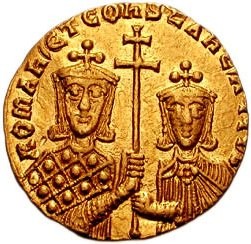
Constantine VII & Romanos II
MILITARY CAMPAIGNS & DIPLOMACY
Constantine's foreign exploits usually saw him face the now familiar enemy of the Arab Caliphate as, fortunately for the Byzantines, Symeon the Bulgar had now been succeeded by the more accommodating Peter and a peace treaty was signed eliminating that particular enemy of the empire. 949 CE saw a failed attempt to take Crete, but Germanikeia on the Mesopotamian frontier was captured the same year. In 953 CE Germanikeia was lost again, but several victories came in the following years, thanks to the able generals Nikephoros II Phokas and John I Tzimiskes, both of whom would be future emperors. Nikephoros, particularly, enjoyed such successes that he became known as the “Pale Death of the Saracens” and even a rumour of his army merely mobilising caused the Arabs to retreat. In 958 CE Tzimiskes led a force which captured the strategically important Samosata on the upper Euphrates river.
The Byzantine Empire was regaining some of its lost lustre and Constantine's court began to attract dignitaries eager to see for themselves this learned young emperor who had set Constantinople back on its feet. The historian L. Brownworth makes the following comments on the diplomatic sparkle Constantine showered on his visiting peers from foreign powers:
Dignitaries and ambassadors from the caliph of Cordoba to the crowned heads of Europe came flocking to Constantinople, where they were dazzled with the breadth of the emperor's knowledge and the splendor of his court. Entertained in the sumptuous palace known as the Hall of the Nineteen Couches, visiting guests would recline to eat in the ancient Roman fashion, clapping in wonder as golden plates laden with fruit would be unexpectedly lowered from the ceiling. Cleverly concealed cisterns would make wine splash from fountains or cascade down carved statues and columns, and an automatic clock in the city ’s main forum would complete the imperial tour de force. Most impressive of all, however, was the emperor himself. (188)
LITERATURE & ARTS
Constantine VII gained a reputation as a great scholar, and we know he was a collector of books, manuscripts, and artworks, and an accomplished painter, too. His most famous written works are the De administrando imperio, a handbook for rulers and diplomats (especially aimed at his son and heir) which includes notes on the cultures bordering the empire, the Dethematibus, on the geography and history of the empire's various provinces, and the De ceremoniis on the protocols and ceremonies of the Byzantine court. Constantine drew on many earlier works, and his own thus preserve a rich Byzantine heritage, undaunted as he was by the task of sifting through the immense imperial archives, as he himself states in one of his books:
Research into history has become clouded and uncertain, either because of the scarcity of useful books or because the quantity of written material has aroused fear and dismay. (Herrin, 182).
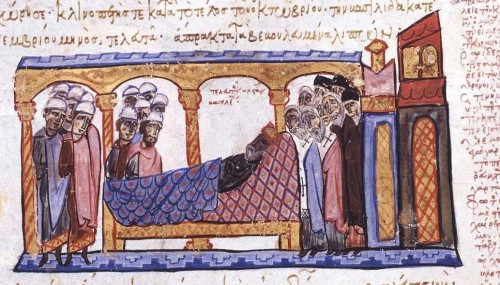
Dying Constantine VII
Constantine was especially keen not to have any tarnish spread to his own image from some of his more dubious predecessors in the Macedonian dynasty, especially its founder Basil. Consequently, he wrote the whitewashed biographical Vita Basilii which became the accepted historical record of Basil's life and achievements. Besides his own literature, Constantine also supported other arts, especially the production of illuminated manuscripts and carved ivories.
DEATH & LEGACY
Constantine's reign was a successful one, and he is remembered today as one of the more accomplished Byzantine rulers, as the historian JJ Norwich here summarises:
He was an excellent Emperor: a competent, conscientious and hard-working administrator and an inspired picker of men, whose appointments to military, naval, ecclesiastical, civil and academic posts were both imaginative and successful. He did much to develop higher education and took a special interest in the administration of justice. That he ate and drank more than was good for him all our authorities seem to agree; but there is unanimity, too, on his constant good humour: he was unfailingly courteous to everyone and was never known to lose his temper. (181)
When Constantine died of natural causes on 9 November 959 CE, he was succeeded by his 20-year old son with Helena Lekapenos, Romanos II. Unfortunately for Romanos, his reign would be a short one, and his throne passed to his two young sons Basil II, “the Bulgar-Slayer”, and Constantine VIII in 963 CE, who would continue the Macedonian dynasty for another half-century.
Empress Zoe › Who Was
Definition and Origins
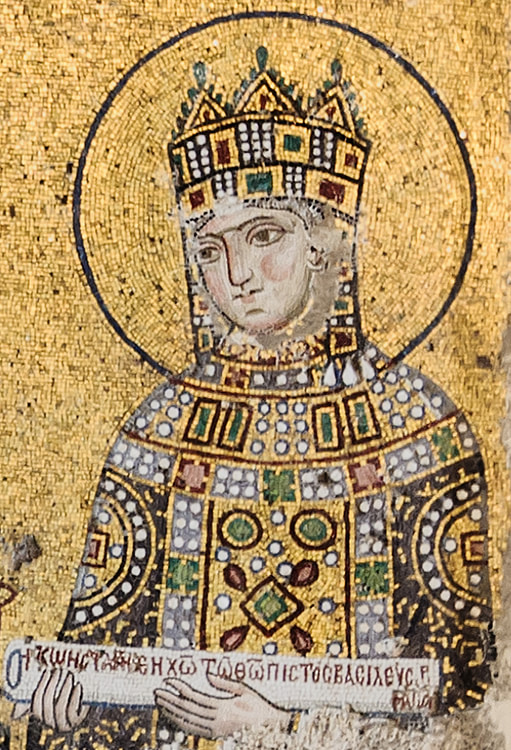
Zoe Porphyrogenita was empress of the Byzantine Empire from 1028 CE until her death in 1050 CE. In an eventful career, she reigned alongside three husbands, had a hand in the succession of her adopted son, and, in 1042 CE, she was co-ruler with her sister Theodora. Zoe is the subject of a colourful and somewhat unflattering biography in the Chronographia of the 11th-century CE Byzantine historian Michael Psellos.
EARLY LIFE
Zoe was born c. 978 CE, one of three daughters of Constantine VIII (r. 1025-1028 CE). She first appears on the stage of history when her uncle emperor Basil II (r. 976-1025 CE) promised her in a marriage of alliance to Otto III (r. 996-1002 CE), the Holy Roman Emperor. Zoe, then 23 and said to have been a great beauty, set sail in 1001 CE from Constantinople, but on arrival at Bari, she was given the sad news that Otto had died of fever. It was one of those moments in history of “what might have been?”, if the imperial families of the two great empires of the west had been united. Instead, Zoe returned home to spend the next 27 years in the seclusion of the Great Palace of Constantinople, but her time would come.
Zoe's character and physique is described in the following terms by the oft-critical Byzantine historian and courtier Michael Psellos (1018 - c. 1082 CE), who had seen the empress with his own eyes when she was in old age:
[Zoe] was regal in her ways, a woman of great beauty, most imposing in her manner and commanding respect…was a woman of passionate interests, prepared with equal enthusiasm for both alternatives, death or life, I mean.In that she reminded me of sea-waves, now lifting a ship on high and then again plunging it down to the depths…Zoe was openhanded, the sort of woman who could exhaust a sea teaming with gold -dust in one day…[she] confused the trifles of the harem with important matters of state…Her eyes were large, set wide apart with imposing eyebrows. Her nose was inclined to be aquiline, and her whole body was radiant with the whitness of her skin ( Zoe & Theodora, Chronographia )
ROMANOS III (HUSBAND NO. 1)
When her father Constantine VIII died of old age without having produced a male heir, Zoe became empress in 1028 CE, her elder sister having long since taken up residence in a monastery. Constantine had prearranged the marriage of Zoe to the aged Romanos Argyrus, the eparch (in effect, mayor) of Constantinople who, now made emperor, became Romanos III. Not at all interested in her father's choice, Zoe conspired with her teenage lover Michael to assassinate Romanos who had taken a mistress of his own and rather unwisely refused Zoe access to the imperial treasury. The emperor was drowned in his bath in 1034 CE. Romanos had not been at all popular with very many other people, either. His reign was seen as a disaster for the Byzantine economy - particularly his policy of cutting taxes for the landed aristocracy and lavishly spending what he could not afford on churches and monasteries. Military matters were no more successful with the low point being a defeat by an Arab army at Aleppo in 1030 CE.
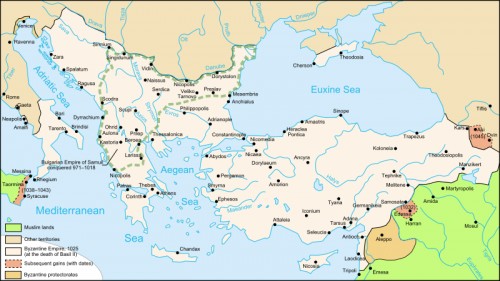
Byzantine Empire, 1025 CE
MICHAEL IV (HUSBAND NO. 2)
Michael thus became emperor in 1034 CE as Michael IV Paphlagon, but he turned out to be something of a schemer himself and promptly had Zoe, now 56, banished to a monastery. Michael's reign was no more successful than his predecessor's with the aristocracy opposed to the undue influence at court of the eunuch John the Orphanotrophos, the brother of Michael IV. A major revolt was led by Peter Deljan over the high rate of taxation and John's unreasonable demand that taxes be paid in cash and not the usual payment in kind. The revolt broke out in 1040 CE, but the tax issue was really only a spark for the real burning issue: the Byzantine domination of the Bulgars. Deljan claimed to be the son (or grandson) of the ex-Tsar Samuel of Bulgaria and the rebels rocked the empire by capturing such important cities as Belgrade, Nish, and Skopje, even unsuccessfully besieging the second most important Byzantine city, Thessalonica. Within a year, though, Deljan was betrayed by his co-rebel ruler Alousianos (son of the present Bulgar Tsar John Vladislav), who gave up his partner to Michael, and the rebellion was quashed.
THE PEOPLE OF CONSTANTINOPLE & THE CHURCH ALWAYS FAVOURED ZOE AS SHE REPRESENTED THE TRUE DYNASTIC LINE.
There were other rebellions besides Deljan's to deal with. Stefan Vojislav, the Prince of Zeta, (aka Duklja in Serbia) had led a revolt in 1034 CE and gained independence for Zeta by winning a battle in the Dyrrachion province in 1042 CE. As with Romanos' reign, defeats abroad contributed to a general feeling of decline as the fringes of the empire continued to be nibbled at by foreign powers. In Michael's case, the losses came in Sicily, which were in no small part due to the emperor being stupid enough to recall his brilliant general George Maniakes from the island and put him in prison in 1040 CE. On top of all these troubles, Michael suffered from epilepsy which was worsening with age even if he was still only in his twenties.
MICHAEL V (THE NEPHEW)
Meanwhile, Zoe may have been removed to a monastery but she was not quite out of the way, and she remained ambitious to regain her throne. She had been encouraged to adopt as her son Michael V, the nephew of Michael IV, by John the Orphanotrophos. John, seeing that his brother was dying, was eager to maintain his powerful position at court by adopting a new protege. Zoe could use the same tool to get back to her rightful position at court. The ailing Michael IV was thus forced to retire to a monastery in 1041 CE where he died of natural causes.
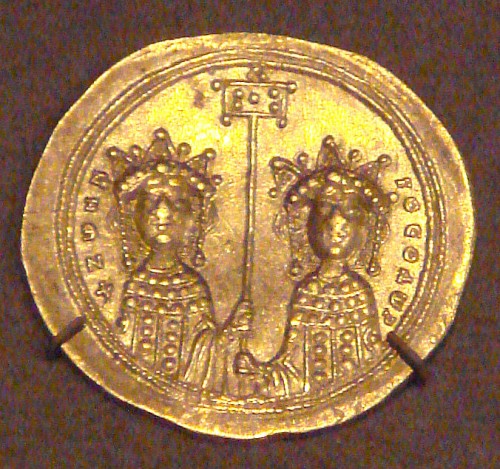
Gold Coin depicting Zoe and Theodora
Michael V Kalaphates was so called because his father was a mere caulker while his mother was the sister of Michael IV. Zoe was obliged to make Michael V the official heir to the throne, but when he became emperor in 1041 CE, he turned on those who had set him up as ruler and banished John the Orphanotrophos from court. Zoe was next in April 1042 CE, when the empress was sent to a monastery for a second time (on Prinkipo, a Marmara island). However, the people of Constantinople and the church favoured Zoe as she represented the true dynastic line. A popular revolt sprang up and a mob trashed the palace and overthrew the young emperor in April 1042 CE. Zoe then co-ruled with her younger sister Theodora, who was also brought out of her retirement in a monastery. The Byzantines now had two old ladies sharing the throne, but at least they had an impeccable imperial pedigree, and the despicable Michael was banished to a monastery. For the people, this light punishment was not enough, though, and so Zoe ordered that he be blinded.
CONSTANTINE IX (HUSBAND NO. 3)
Zoe, no doubt because of her age (then 64 years old) and previous experience, was given precedence over her sister - her throne, for example, was set slightly further forward than Theodora's at their re-coronation ceremony. Hoping to start a new chapter of Byzantine history, the sisters made new court appointments, ruled against corrupt practices like selling titles, and instigated an enquiry into the transgressions of their predecessor.
Zoe cemented her position by choosing a new husband, her third. Constantine Monomachos was a rich and elegant choice, long-admired by the empress, and so he was recalled from his exile on Lesbos. Married in June 1042 CE, the aristocrat with an outrageous reputation as a ladies' man became emperor Constantine IX Monomachos (r. 1042-1055 CE). Constantine did have experience of Byzantine government as he had been a senior civil administrator, and he had some pedigree, being related to Romanos III.
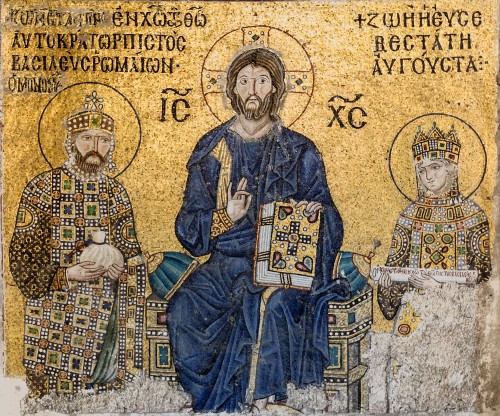
Constantine IX & Empress Zoe
In an unprecedented arrangement, Constantine co-ruled with Zoe and Theodora. To complicate matters even further, Constantine installed his long-time lover Sclerina in the palace, a move seemingly blessed by Zoe. The public was not quite so tolerant of this confusing division of power and called for Sclerina's removal - a quandary solved by her sudden death from a pulmonary disease.
One of the new emperor's first acts was to banish the scheming John from court for a second time in his career, punishing him with the all-too-frequent Byzantine mutilation of blinding. Constantine set about reforming the administration of the empire, but this contributed to two major revolts led by the generals George Maniakes and Leo Tornikios (the emperor's nephew) in 1043 CE and 1047 CE respectively. The emperor surrounded himself at court with noted intellectuals, Michael Psellos amongst them but his neglect of the army had long-term consequences, even if a Rus attack on Constantinople was thwarted in 1043 CE. The empire was crumbling at the frontiers with the Normans making inroads into southern Italy, the Pechenegs threatening the Balkans, and the Seljuks expanding in Asia Minor. Constantine might have skimped on the army but he still found resources to build lavish monasteries and give gifts to his aristocratic cronies.
DEATH
In 1050 CE, as the Empire was experiencing some of its darkest days, Zoe died. Despite three marriages, she had never had a child, and when her sister Theodora died in 1056 CE, so the Macedonian dynasty founded by Basil I (r. 867-886 CE) died out. Zoe lives on, though, in popular memory thanks to her colourful life, the biography by Psellos and the famous gold and glass mosaic of the Hagia Sophia in Constantinople. Here the Empress is portrayed alongside Constantine IX with Jesus Christ between them in an act of blessing. Situated on the east wall of the south gallery, each gives donations to Christ, and Zoe wears a stunning jewelled-robe and crown. Above her is an inscription which reads “Zoe, the most pious Augusta”. The mosaic interestingly reflects Zoe's turbulent personal life because on close inspection one can see that the heads of all three figures have been altered as the original mosaic perhaps honoured Zoe's first husband Romanos III or even her nephew Michael V.
LICENSE:
Article based on information obtained from these sources:with permission from the Website Ancient History Encyclopedia
Content is available under License Creative Commons: Attribution-NonCommercial-ShareAlike 3.0 Unported. CC-BY-NC-SA License